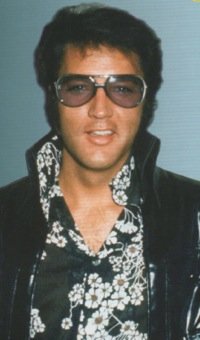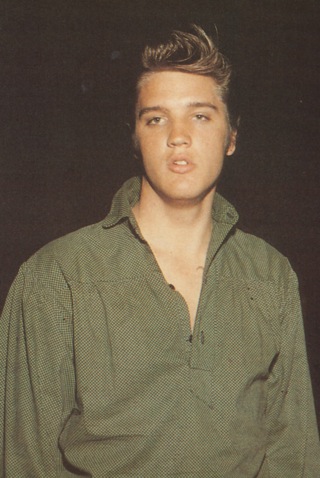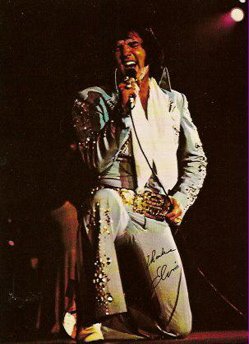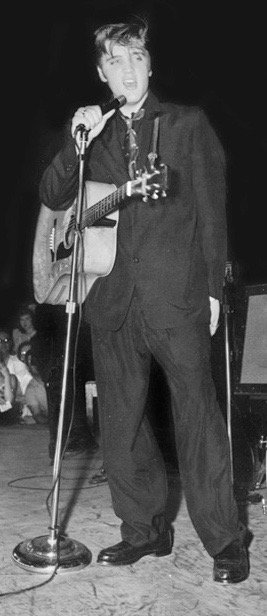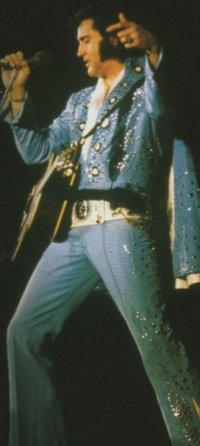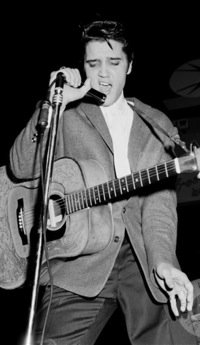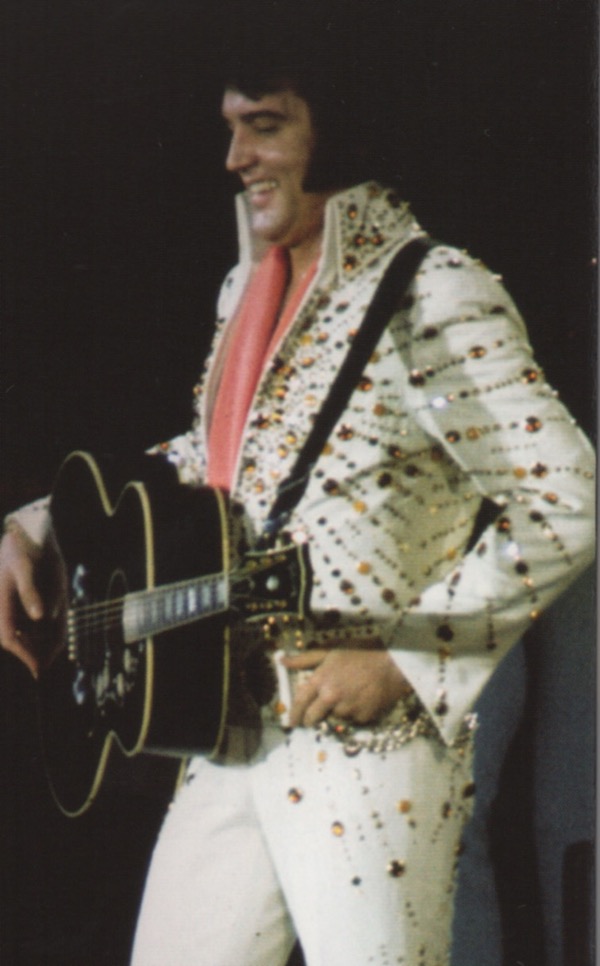Elvis History Blog
Elvis in Albuquerque …
1956 and 1972
The citizens of nearly 70 American cities had the opportunity to see Elvis Presley on stage in both the 1950s and the 1970s. Half of them are in the South. One of the more unusual towns on the list is Albuquerque, New Mexico. It’s not that there’s anything unusual about Albuquerque. It’s just that in the ’50s Elvis rarely performed in the desert states of the Southwest. Putting aside Las Vegas, the showrooms of which Elvis would have played no matter where they were located, Elvis played only three Southwestern cities in both the ’50s and ’70s—Phoenix, Tucson, and Albuquerque.

Elvis took his show to New Mexico’s largest city on April 12, 1956, and then again on April 19, 1972. Comparing those two appearances gives some insight into how Elvis and his fans changed during those 16 years.
By the spring of 1956, Elvis Presley’s star was ascending rapidly. He had appeared seven times on nationally broadcast TV variety shows, most recently the Milton Berle show on April 3. His first RCA single, “Heartbreak Hotel,” was storming up Billboard’s Top 100. He had just signed a long-term contract with Paramount pictures, and his personal appearances were drawing increasingly larger and wilder crowds. In early April, Elvis interrupted his brief tour of Texas to take his show into New Mexico for a day.
• Elvis in Albuquerque | April 12, 1956
Ads for Presley’s show began appearing in the Albuquerque Tribune and Journal on April 6. Elvis would headline two shows at the city’s Armory on Thursday the 12th. Among those also on the bill were “Grand Ole Opry” stars Faron Young and Wanda Jackson. Advance tickets were $1.50 for the main floor and $1.25 in the balcony. “Buy Now and Save a Quarter!” advised the ads in reference to the added cost of tickets at the door.
According to the Tribune, Presley “attracted one of the largest crowds ever to attend a performance at the Armory.” Obviously, no one from the Tribune was part of that crowd, as the paper’s article the next day focused only on the aftermath of Elvis’s show. Fortunately, though, Lionel Crane, the Hollywood correspondent for the London Daily Mirror made the trip out to the dessert to see and report on Elvis for his readers across the pond.

“I have just escaped from a hurricane called Elvis Presley,” was the lead in Crane’s April 30 review in the Mirror. “I’ve never seen anything like it. When Elvis sings it isn’t just a case of a few girls sighing and going swoony or stamping and shouting. I saw him send 5,000 of them into a mass fit of screaming hysterics.”
Crane’s description of the attire Elvis fans wore that evening fit right in with the frontier image of Albuquerque. “The girls wore suede-fringed jackets, check shirts, jeans held up by leather belts with silver buckles and moccasins. The boys wore curly brimmed flat-top Western-style hats, jeans and high-heeled boots.”
The British journalist provided a vivid description of both Presley and his performance. “Elvis came in carrying his guitar and wearing a plum-coloured jacked and black trousers … He has the build of a guardsman, an unbeatable D.A. haircut, sleepy eyes like Robert Mitchum and a handsome, olive coloured face. As he sings he stands with his legs wide apart. His whole body from his shoulders to his feet shakes in rhythm and every move draws a new deluge of howls from ecstatic fans. A few seconds after he started, sweat was dripping over his eyebrows and his hair was hanging down his forehead. Every new number was greeted with screams; every rhythmic break got a howl.”
Crane saw girls with cameras rushing down to the stage, only to kneel in awe when they got there, forgetful of taking pictures. He took special note of one little, blonde girl. “She had found a broken string from Elvis’ guitar,” he explained. “When I left she was rolling it reverently round like a lock of hair and tucking it down inside her skirt.”
Much of Naomi Callarman’s next-day article in the Tribune focused on another Albuquerque girl who received the greatest of all souvenirs directly from Elvis. “We were all crowded up there at the door waiting for him to come out,” explained 13-year-old Carla Singer of the scene outside the Armory after Elvis’s second show. “He kissed two or three of the girls … but they were just sort of friendly kisses on the cheek. He looked over at me real sweet and reached out his arms and put them around me and kissed me … really kissed me, not just a friendly kiss.” (Carla’s friend claimed that Elvis even closed his eyes during the kiss.) “I’m still just dazed,” Carla told Callarman. “I’ll never forget it ever. It was the MOST wonderful thing that’s ever happened to me.”
The next day Carla was all fired up about starting an “Elvis Presley Fan Club” in Albuquerque. She would be 29 years old before Elvis came back to her town.
• Interlude
Much would happen in Elvis Presley’s life and career before he returned to Albuquerque. When he left the city in 1956, he had released just one single record and one LP for RCA. By the time he came back in 1972, he had 82 singles and 52 LPs in his catalog. He had no #1 records to his credit in April 1956. (“Heartbreak Hotel” didn’t reach #1 until May 5.) When he came back in 1972, he had topped the singles chart 14 times. Between his two Albuquerque appearances, Elvis made 31 Hollywood movies and starred in his first TV special.
There had been many changes in his personal life as well. He was 21 when he first came to Albuquerque; he came back at age 37. He had served a hitch in the army, gotten married and become a father. It was a different Elvis and a different audience when he finally brought his show back to Albuquerque on April 19, 1972, exactly 16 years and one week after his first appearance there.
• Elvis in Albuquerque | April 19, 1972
“It’s been a long time since I was in Albuquerque,” Elvis told the 11,857 people who jammed Tingley Coliseum that evening. “And it’s fantastic to be back. I hope y’all enjoy the show.”
This time the crowd was not dominated by young girls. “They were young and old, superbly-dressed and shabbily-dressed,” noted Charles Wood in his Tribune review the following day. Their attire ranged “from hotpants to pedal-pushers, from evening gowns to blue jeans.”
Elvis had changed, too. “He wore a white, military-type shirt with a baby blue cape,” Wood reported. “His shirt was open from the collar to his waist. Elvis, now 37, looked like you’d expect a musical superstar to look.”
As in ’56, Elvis strummed a guitar during his first number, but this time he had a 26-piece band behind him instead of just Scotty, Bill, and DJ. Over the next 50 minutes, he sang some old ones (“Love Me Tender,” “Heartbreak Hotel,” “Hound Dog,” “Don’t Be Cruel”) and some new ones (“C.C. Ryder,” “Polk Salad Annie”). “His old songs received the biggest rounds of applause,” Wood observed. “Teenagers screamed. Young people applauded. And older people sat back and enjoyed it all.”
Meanwhile, outside the coliseum hundreds of people gathered around the stage door, just liked Carla Singer and her friends had done 16 years before. They hoped for an autograph or maybe a kiss, but they would settle for just a glimpse of Elvis. But the hopes of everyone waiting outside for Elvis in Albuquerque that night would be dashed.
Inside, Elvis finished his performance, dropped the microphone, and hurried off the stage. “Elvis didn’t stop running until he reached a side exit where a chauffeured limousine waited,” explained Wood. “It whisked him off to his private plane on which he would fly home.”
Elvis had left the building, and like many communities in those years, Albuquerque had no way of knowing that this time Elvis Presley would never come back. — Alan Hanson | © March 2011
Go to Elvis on Stage
Go to Home Page
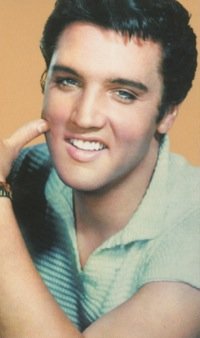
"When Elvis left the city in 1956, he had released just one single record and one LP for RCA. By the time he came back in 1972, he had 82 singles and 52 LPs in his catalog."
